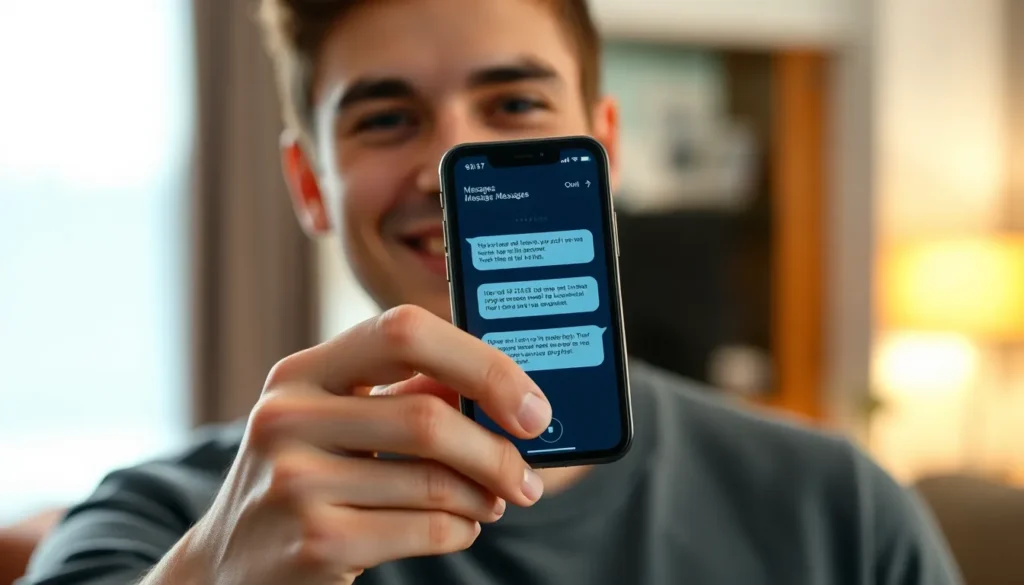Table of Contents
ToggleIn a world where sharing is caring, sending files through text messages can feel like trying to find a needle in a haystack. But fear not! Attaching a file to a text message on an iPhone is as easy as pie—or at least easier than explaining to your grandma why she can’t find the “any” key.
Understanding File Attachments on iPhone
Attaching files to a text message on an iPhone involves a simple understanding of the device’s capabilities. Users can share photos, videos, documents, and audio clips effortlessly. Apple’s Messages app supports various file types, making it convenient to send and receive diverse media.
Photos and videos require minimal steps. Users select the Messages app, tap the camera icon, and choose media from the library. Alternatively, they can access the Files app for document attachments. This app holds everything from PDFs to Word documents.
Audio clips enhance conversations. Users record and send voice messages directly within the Messages app. This feature allows for quick communication without typing.
File size limits exist. A single message can accommodate attachments up to 300 MB. Understanding this limit helps prevent sending large files causes delays. Users will see notifications if files exceed this limit.
Additionally, Wi-Fi or cellular data is needed to send attachments. Stable internet connections ensure smooth file transfers. Sending files may incur data charges for non-Wi-Fi backups.
Regularly updating iOS enhances app functionality. New updates often include performance improvements and more features, ensuring a tailored experience for communication. Users who follow these steps and practices can enhance their messaging experience on an iPhone.
Steps to Attach a File to a Text Message

Attaching a file to a text message on an iPhone involves a few simple steps. Users can share different types of files quickly and efficiently.
Using the Messages App
Open the Messages app to start. Tap the conversation to which you’d like to send a file. To attach a photo or video, select the camera icon near the text field. Users can either take a new photo or video or choose existing media from their library. For documents, access the Files app. Tap the app icon, locate the desired document, and select it to attach. After completing these actions, hit the send button to deliver the file.
Using Third-Party Apps
Third-party apps also facilitate file sharing. Popular options include WhatsApp, Dropbox, and Google Drive. Open your preferred app and select the conversation that you want. Users can typically find a paperclip or attachment icon within these applications. Tap on this icon, choose the type of file to share, and navigate to the selected document, photo, or video. Once chosen, complete the action by tapping send. Various third-party apps enhance this process by allowing larger file uploads.
Types of Files You Can Attach
iPhones support various file types for attachment in text messages. Users can share multiple formats, enhancing communication flexibility.
Images and Videos
Images and videos rank among the most popular file types. To attach them, users tap the camera icon within the Messages app. They can either capture a new photo or select existing media from the library. Supported formats include JPEG, PNG, and MP4, ensuring high quality. Keep in mind, each attachment counts toward the 300 MB file size limit. Users typically prefer sending images and videos for both personal and professional communication.
Documents and Other Formats
Documents also feature prominently among the attachable files. Users access documents through the Files app by tapping the appropriate icon in the Messages app. Supported formats include PDF, DOCX, and TXT, making it easy to share essential information. The 300 MB limit applies here as well, encouraging users to send concise files. Other formats like audio clips and spreadsheets can also be attached, allowing for versatile communication options.
Troubleshooting Common Issues
Users may encounter several issues when attaching files to text messages on iPhones. Understanding these common problems allows for quicker resolutions.
First, if the attachment fails to send, checking the internet connection is crucial. A stable Wi-Fi or cellular data connection is required. Users often find that weak signals hinder the sending process.
Next, file size limits can pose challenges. iPhone users cannot attach files larger than 300 MB. Reducing the file size or compressing files can help overcome this limitation.
Additionally, file format incompatibility may arise. While iPhones support formats like JPEG, PNG, and MP4, some rarely used formats cause issues. Confirming that files are in compatible formats ensures smooth sharing.
Operating system updates play a significant role in app functionality. Users should regularly update their iOS to fix bugs and improve performance. An outdated OS might lead to features not working correctly.
Another potential issue involves the Messages app settings. Enabled settings allow users to share media seamlessly. Users might verify these settings to ensure attachment options are available.
Lastly, app-specific problems can occur with third-party applications. Users experiencing issues with apps like WhatsApp or Dropbox should check for updates or reinstall them. This action often resolves unexpected errors.
By staying informed about these troubleshooting techniques, users can enhance their experience when attaching files to text messages on their iPhones.
Attaching files to a text message on an iPhone is a simple yet effective way to enhance communication. Whether sharing cherished memories through photos or important documents, the process is designed to be user-friendly. By utilizing the Messages app or third-party applications, users can easily send various file types while staying within size limits.
Maintaining a stable internet connection and keeping the iOS updated ensures smooth file sharing experiences. With these tips in mind, users can confidently navigate the world of file attachments, making their conversations richer and more informative. Embracing these straightforward methods will undoubtedly streamline communication and foster connections.




